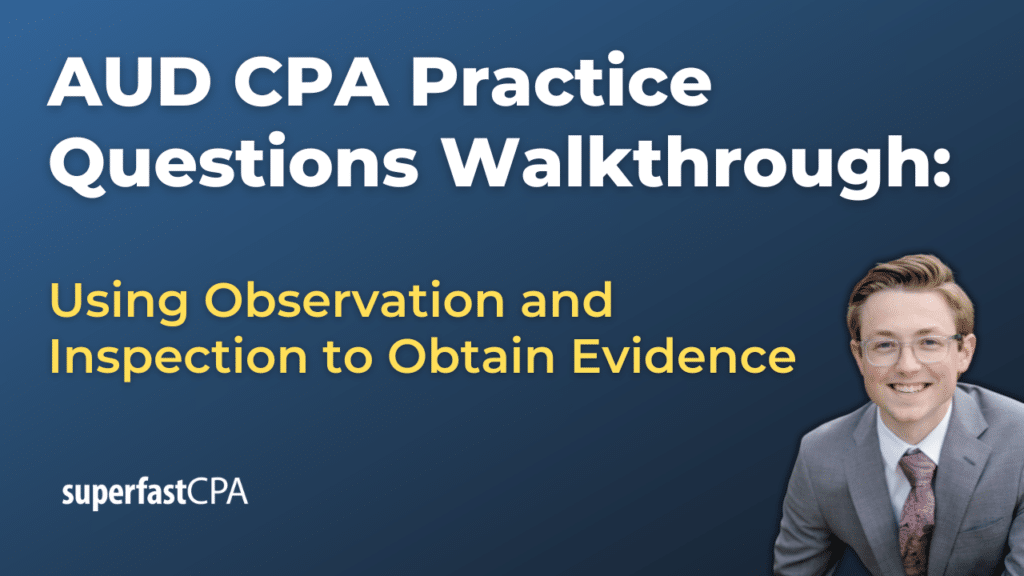In this video, we walk through 5 AUD practice questions teaching about using observation and inspection to obtain evidence. These questions are from AUD content area 3 on the AICPA CPA exam blueprints: Performing Further Procedures and Obtaining Evidence
The best way to use this video is to pause each time we get to a new question in the video, and then make your own attempt at the question before watching us go through it.
Also be sure to watch one of our free webinars on the 6 “key ingredients” to an extremely effective & efficient CPA study process here…
Using Observation and Inspection to Obtain Evidence
Auditors rely on a variety of procedures to gather sufficient, appropriate evidence to support their conclusions. Two key procedures for obtaining evidence are observation and inspection. While both methods help verify the accuracy of financial statements, they serve different purposes and support different audit assertions. This guide breaks down the use of observation and inspection in audits, including when to use them, what they test, and how they fit into tests of controls and substantive procedures.
Observation: Capturing Real-Time Processes
Definition: Observation involves watching a process or activity as it occurs to determine whether it is being performed correctly. The auditor does not physically examine documents or assets but instead assesses procedures in real time.
Key Assertions Supported:
- Existence: Confirms that an activity or asset is actually present.
- Completeness: Ensures that all transactions or activities are being recorded properly.
Examples of Observation in an Audit:
- Watching employees conduct a physical inventory count to verify that it is performed correctly (existence).
- Observing the shipment of goods to confirm that all outgoing items are recorded as sales (completeness).
- Watching a manager review and approve purchase orders to confirm that an approval control is being followed (test of controls).
Limitations of Observation:
- Only provides evidence at a specific moment in time and does not show consistency over a period.
- People may alter their behavior when they know they are being observed.
Inspection: Examining Documents and Assets
Definition: Inspection involves reviewing records, documents, or physical assets to verify their existence, accuracy, and compliance with accounting standards.
Key Assertions Supported:
- Existence: Verifies that an asset or transaction is real.
- Valuation and Allocation: Confirms that assets and liabilities are recorded at the correct amounts.
- Rights and Obligations: Determines whether the entity owns the asset or is responsible for the liability.
- Occurrence: Ensures that a recorded transaction actually took place.
Examples of Inspection in an Audit:
- Examining vendor invoices to verify the recorded cost of inventory (valuation and allocation).
- Reviewing property deeds to confirm ownership of real estate (rights and obligations).
- Inspecting bank statements to confirm cash balances (existence).
- Checking sales invoices and shipping documents to verify that a sale actually occurred (occurrence).
Why Inspection is More Reliable Than Observation:
- Provides physical or documentary evidence that can be retained and re-evaluated.
- Is less subjective and can be applied over a longer period, unlike observation, which only captures a single moment.
Distinguishing Between Tests of Controls and Substantive Procedures
Auditors use observation and inspection in both tests of controls and substantive procedures, depending on the audit objective.
Tests of Controls
- Purpose: Evaluates whether internal controls are functioning as intended.
- Example Using Observation: Watching an employee enter a password before approving a transaction to ensure access controls are enforced.
- Example Using Inspection: Reviewing signed approval forms to verify that all purchases above a threshold were properly authorized.
Substantive Procedures
- Purpose: Directly tests financial statement balances and transactions.
- Example Using Observation: Watching an inventory count to confirm physical quantities align with accounting records.
- Example Using Inspection: Reviewing vendor invoices to ensure inventory purchases are recorded at the correct cost.
Key Takeaways
- Observation is useful for evaluating real-time activities and is commonly used to test existence and completeness.
- Inspection provides more reliable evidence than observation because it involves reviewing tangible documentation and assets, supporting valuation, rights and obligations, existence, and occurrence.
- Observation is often used in tests of controls, while inspection can be used in both tests of controls and substantive procedures.
- Observation is limited to a single point in time, whereas inspection provides evidence that can be retained and reviewed later.
- Auditors typically combine observation with inspection or other procedures to ensure comprehensive audit evidence.














